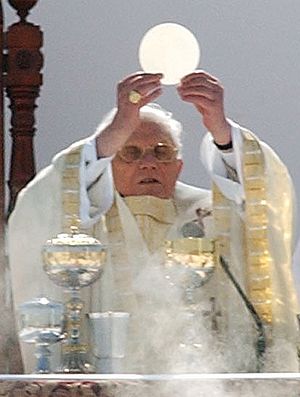The answer to this question will not be in its final form for a long time. The papacy only ended a few weeks ago. Historians will have to look at several things before they will be able to reflect back with greater precision that a video or a blog commentary can provide in 2013. There are several things that Pope Benedict’s 8 year reign that give good indicators as to what we engage with in the years ahead. Many more intelligent than I have thought this question through, but Father Robert Barron of the Archdiocese of Chicago has made a good first attempt when he posits that Benedict will be remembered for:
1. being able to give a more authentic interpretative key to the Second Vatican Council; that is, naming the true mission of the Church;
2. being able to present the objective truth of the faith as taught by the Church these 2 thousand years with the clear awareness that the truth is about the Divine Love lived in joy; this is often called affirmative orthodoxy: the big ‘yes’ vs. the fat ‘no’;
3. being able to articulate a reasonable Catholic Christology (that Jesus Christ, the Incarnate Word of God, and final Adam is the author of all truth and is for all peoples) by moving us away from the exclusive use of a Thomistic theology based on a rationalism to a Patristic method which focuses on the tripod of sacred Scripture, sacred Liturgy and the writings of the Church Fathers (and Mothers); Benedict works hard to present the revelation presented in Gaudium et Spes 22; the Patristic method is most notably identified as the nouvelle théologie movement with the works of Cardinal Henri de Lubac, Cardinal Jean Danielou, Cardinal Yves Congar and Cardinal Hans Urs von Balthasar; you would see the use of the Mystical Body of Christ and the Communio sanctorum as a reference points.
AND I would add 3 points:
4. being able to refocus our worship on the Triune God and not on human beings by the crucial emphases on the beauty of the sacred Liturgy, sacred music (polyphony, Gregorian chant and hymnody) and liturgical preaching; beauty also illustrated by “Catholic” architecture, liturgical gestures, silence and vestiture;
5. being able to recover the Catholic “both/and’ in the bridging of faith and reason;
6. being able to ask for change in the manner of living the Catholic life attending to the stuff of the heart.
Whatever is said here points more the vocation and mission of the Church today than to the person of Benedict. His aim was to point to the face of Christ and the work of the Church than to himself. The first focus, therefore, always has to be on what the Gospel reveals because the Gospel is the orientation of what we believe and how we live.
Father Barron’s video clip on Benedict XVI legacy can be accessed here.

